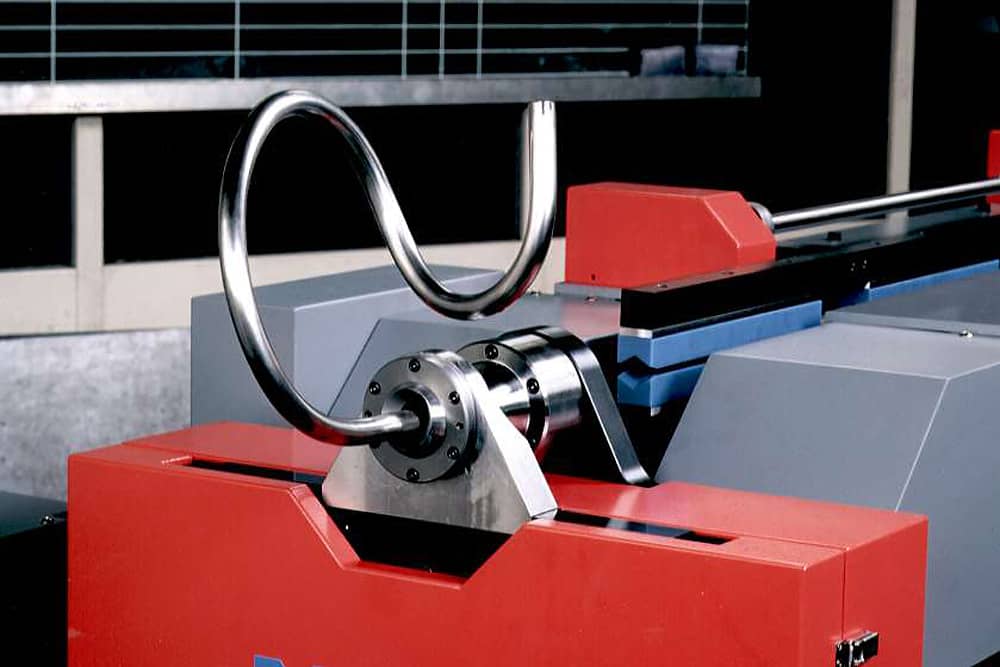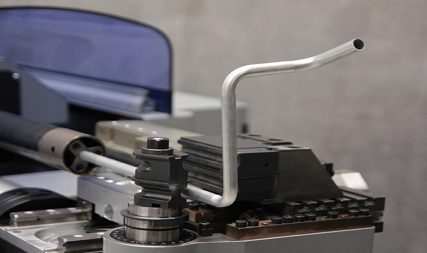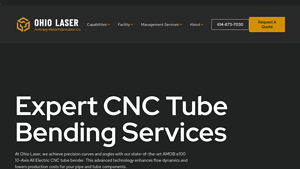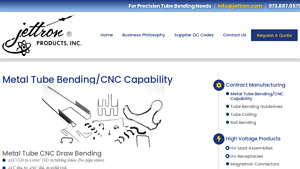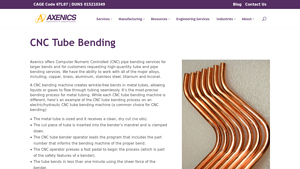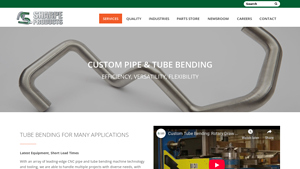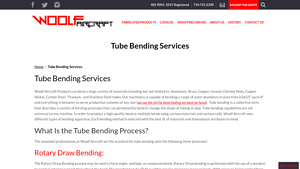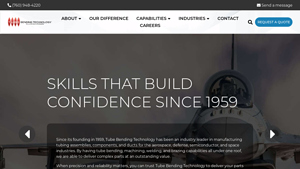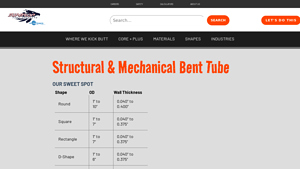Cnc Tube Bending Service Guide: Type, Cost, Top List…
Introduction: Navigating the Global Market for cnc tube bending service
In an increasingly competitive global landscape, sourcing reliable CNC tube bending services can be a daunting challenge for international B2B buyers. Companies across various sectors, from automotive to construction, require high-quality, precision-bent tubes that meet stringent specifications and performance standards. This guide serves as a comprehensive resource for navigating the complexities of CNC tube bending, covering essential topics such as different bending methods, applications across industries, and strategies for vetting suppliers effectively.
Buyers from regions such as Africa, South America, the Middle East, and Europe, including markets like Saudi Arabia and Brazil, will find valuable insights on optimizing their procurement processes. We delve into the nuances of various bending technologies, such as mandrel and rotary draw bending, while also addressing considerations like material selection and cost-effectiveness. Understanding the capabilities of potential suppliers is crucial, and we provide actionable tips for evaluating quality, turnaround times, and technological advancements in CNC tube bending.
By leveraging the information in this guide, B2B buyers can make informed purchasing decisions that not only enhance product quality but also drive operational efficiency and cost savings. Our goal is to empower you with the knowledge to navigate the global market confidently, ensuring that your manufacturing projects achieve the desired outcomes.
Understanding cnc tube bending service Types and Variations
| Type Name | Key Distinguishing Features | Primary B2B Applications | Brief Pros & Cons for Buyers |
|---|---|---|---|
| Rotary Draw Bending | Utilizes a single-axis rotation to create bends. | Automotive, Aerospace, Furniture | Pros: High precision, versatile. Cons: Limited to certain tube sizes. |
| Mandrel Bending | Uses a mandrel inside the tube to maintain shape. | Energy, Construction, HVAC | Pros: Better control over tight bends. Cons: More complex setup. |
| Compression Bending | Employs compressive forces to bend tubes. | General Manufacturing, Agricultural Equipment | Pros: Cost-effective for simple shapes. Cons: Less precision. |
| 3D Bending | Allows for multi-planar bends to create complex geometries. | Aerospace, Robotics, Custom Fabrications | Pros: Capable of intricate designs. Cons: Higher cost and longer lead times. |
| Hydroforming | Uses fluid pressure to form tubes into desired shapes. | Automotive, Aerospace, Medical Devices | Pros: Excellent for complex shapes, smooth finishes. Cons: Requires specialized equipment. |
What Are the Key Characteristics of Rotary Draw Bending?
Rotary draw bending is characterized by its ability to create precise bends using a single-axis rotation mechanism. This method is highly effective for producing consistent and repeatable bends, making it ideal for applications in the automotive and aerospace sectors, as well as furniture manufacturing. When considering this option, buyers should evaluate the specific tube sizes required, as this technique has limitations in terms of diameter and wall thickness.
How Does Mandrel Bending Enhance Tube Forming?
Mandrel bending involves inserting a mandrel into the tube during the bending process, which helps maintain the tube’s internal shape and minimizes deformation. This method is particularly suitable for industries that require tight bends without collapsing the tube, such as energy and construction. B2B buyers should consider the complexity of their designs, as mandrel bending can accommodate intricate shapes but may entail a more complex setup and longer lead times.
In What Scenarios is Compression Bending the Best Choice?
Compression bending is a straightforward method that uses compressive forces to achieve bends in the tube. This technique is often employed in general manufacturing and agricultural equipment where high precision is not critical. While it offers a cost-effective solution for simpler shapes, buyers should be aware that it may not meet the stringent tolerances required for more complex applications.
What Advantages Does 3D Bending Offer for Complex Designs?
3D bending allows for multi-planar bends, enabling the creation of intricate geometries that are often necessary in aerospace and robotics applications. This method is advantageous for projects requiring custom fabrications with unique specifications. However, buyers should be prepared for potentially higher costs and longer lead times due to the complexity of the setup and execution.
When Should You Consider Hydroforming for Your Projects?
Hydroforming utilizes fluid pressure to shape tubes into complex forms, making it an excellent choice for industries like automotive, aerospace, and medical devices where precision and surface finish are paramount. This method produces smooth curves and intricate designs. However, it requires specialized equipment, so buyers should assess their production volumes and design requirements before opting for this technique.
Key Industrial Applications of cnc tube bending service
| Industry/Sector | Specific Application of CNC Tube Bending Service | Value/Benefit for the Business | Key Sourcing Considerations for this Application |
|---|---|---|---|
| Agriculture | Precision components for irrigation systems and farm machinery | Enhanced durability and efficiency in operations | Material selection, weather resistance, and custom designs |
| Automotive | Exhaust systems and structural components for vehicles | Improved performance and safety standards | Compliance with industry regulations, weight considerations |
| Aerospace | Hydraulic and fuel system tubing | High precision and reliability in critical applications | Aerospace-grade materials, strict tolerances, and certifications |
| Energy | Custom bent pipes for renewable energy structures | Increased efficiency and reduced installation time | Compatibility with existing systems, corrosion resistance |
| Furniture | Curved tubing for aesthetic furniture designs | Unique designs that enhance market appeal | Customization options, material finishes, and lead times |
In the agriculture sector, CNC tube bending services are crucial for producing precision components used in irrigation systems and farm machinery. By creating durable, custom-shaped tubes, businesses can enhance the efficiency of their operations and reduce maintenance costs. Buyers must consider material selection, ensuring that components can withstand diverse weather conditions, particularly in regions like Africa and South America where environmental factors vary significantly.
The automotive industry heavily relies on CNC tube bending for manufacturing exhaust systems and structural components. This technology allows for the creation of complex shapes that optimize vehicle performance while adhering to safety standards. International buyers should focus on sourcing from suppliers that comply with stringent industry regulations and can provide lightweight materials to improve fuel efficiency.
In the aerospace sector, the need for high precision is paramount. CNC tube bending is employed to produce hydraulic and fuel system tubing that meets rigorous safety and performance standards. Buyers in this field must prioritize suppliers that use aerospace-grade materials and can achieve tight tolerances, as well as those who possess the necessary certifications to ensure compliance with international standards.
The energy sector benefits from CNC tube bending services by utilizing custom-bent pipes for renewable energy applications, such as wind turbines and solar panel structures. This service not only improves installation efficiency but also enhances the overall durability of the components. Buyers should consider the compatibility of the bent tubes with existing systems and the materials’ resistance to corrosion, especially in harsh environments prevalent in the Middle East and coastal regions.
In the furniture industry, CNC tube bending allows for the creation of aesthetically pleasing curved components that elevate design appeal. This application enables manufacturers to offer unique products that stand out in a competitive market. When sourcing, businesses should focus on customization options, material finishes, and lead times to ensure they can meet market demands effectively.
3 Common User Pain Points for ‘cnc tube bending service’ & Their Solutions
Scenario 1: Delays in Production Due to Inaccurate Specifications
The Problem: B2B buyers often face significant delays in production caused by inaccuracies in tube bending specifications. When designs are not communicated effectively, or when the supplied files (such as STP or DXF) contain errors, manufacturers may produce parts that do not meet the specified tolerances. This misalignment can lead to rework, wasted materials, and ultimately, delayed project timelines. For businesses operating on tight schedules, these setbacks can jeopardize client relationships and lead to financial losses.
The Solution: To mitigate this risk, buyers should invest time in detailed design documentation before submitting orders. Providing clear and precise specifications is essential. Use standardized templates for design files and include comprehensive notes that outline specific requirements, tolerances, and any critical dimensions. Engaging with the CNC tube bending service provider during the design phase can also facilitate better communication. Many providers offer Design for Manufacturing (DFM) services to help refine designs, ensuring they are optimized for production. This proactive approach not only streamlines the manufacturing process but also enhances the quality of the final product, reducing the likelihood of costly delays.
Scenario 2: Difficulty in Achieving Complex Shapes and Configurations
The Problem: Another common pain point for B2B buyers is the challenge of obtaining complex tube shapes that meet specific functional and aesthetic requirements. As industries evolve, the demand for intricate designs has increased, yet many buyers are unsure about the capabilities of CNC tube bending services. This uncertainty can lead to frustration when the final product does not align with the envisioned design, impacting both functionality and brand image.
The Solution: Buyers should conduct thorough research into the capabilities of potential CNC tube bending service providers before placing an order. Understanding the various bending techniques available, such as mandrel bending and rotary draw bending, is crucial. These methods can offer the flexibility needed for complex geometries. When discussing your project, provide sketches or 3D models to illustrate your design vision clearly. Additionally, inquire about the provider’s experience with similar projects and their technology, such as real-time monitoring systems that ensure precision. By collaborating closely with experts during the design and prototyping stages, buyers can achieve the desired shapes while ensuring functionality and aesthetic quality.
Scenario 3: Limited Material Options Leading to Compromised Quality
The Problem: Many B2B buyers encounter challenges related to material selection when sourcing CNC tube bending services. Limited options can restrict the ability to choose materials that meet specific performance criteria, such as corrosion resistance or strength. This limitation often results in compromised product quality, which can affect the durability and overall performance of the final components, leading to potential failures in the field.
The Solution: To address this issue, buyers should prioritize working with CNC tube bending service providers that offer a diverse range of materials. When selecting a provider, inquire about their material capabilities and ensure they can work with the specific metals required for your project, such as stainless steel, aluminum, or special alloys. Additionally, leverage the expertise of the provider’s engineering team to discuss the benefits and drawbacks of various materials in relation to your specific application. This collaborative approach will help you make informed decisions that enhance product quality and performance, ultimately delivering greater value to your end customers.
Strategic Material Selection Guide for cnc tube bending service
What Are the Key Properties of Common Materials Used in CNC Tube Bending Services?
When selecting materials for CNC tube bending services, it’s crucial to consider their properties, advantages, and limitations to ensure optimal performance in specific applications. Here, we analyze four common materials: stainless steel, aluminum, carbon steel, and special alloys.
How Does Stainless Steel Perform in CNC Tube Bending Applications?
Stainless steel, particularly grades 304 and 316, is renowned for its excellent corrosion resistance and strength. It can withstand high temperatures and pressures, making it suitable for applications in industries such as automotive, aerospace, and energy. The key advantage of stainless steel is its durability, which ensures longevity in harsh environments. However, it tends to be more expensive than other materials and can be challenging to bend due to its hardness, which may increase manufacturing complexity.
For international buyers, compliance with standards such as ASTM A312 (for welded pipes) and DIN 17440 (for stainless steel) is essential. Regions like Europe and the Middle East often have stringent quality requirements, so sourcing from certified suppliers is advisable.
What Are the Benefits of Using Aluminum in CNC Tube Bending?
Aluminum, especially the 6061 grade, is lightweight yet strong, making it a popular choice for applications requiring reduced weight without compromising strength. Its natural resistance to corrosion and ease of fabrication make it ideal for industries such as transportation and construction. The primary advantage of aluminum is its cost-effectiveness and versatility, as it can be easily shaped into complex geometries.
However, aluminum has lower temperature and pressure ratings compared to stainless steel, which may limit its use in high-stress applications. International buyers should be aware of common standards like ASTM B221 for extruded aluminum, ensuring compliance with local regulations, especially in regions like South America and Africa, where material sourcing can vary.
Why Choose Carbon Steel for CNC Tube Bending Projects?
Carbon steel is a widely used material in CNC tube bending due to its strength and affordability. It is particularly suitable for structural applications, such as construction and automotive frames. The key advantage of carbon steel is its robustness and ability to handle high loads, which makes it ideal for heavy-duty applications.
On the downside, carbon steel is prone to rust and corrosion, necessitating protective coatings or treatments. Buyers from regions with high humidity or saline environments, such as coastal areas in Brazil or the Middle East, should consider these factors. Compliance with standards like ASTM A500 (for structural tubing) is also crucial for ensuring quality and safety.
What Are the Considerations for Using Special Alloys in CNC Tube Bending?
Special alloys, such as Inconel and titanium, offer unique properties like high-temperature resistance and exceptional strength-to-weight ratios. These materials are commonly used in aerospace and specialized industrial applications where performance is critical. The main advantage of special alloys is their ability to perform under extreme conditions, which can justify their higher cost.
However, bending special alloys can be more complex and may require specialized equipment, increasing manufacturing costs and lead times. For international buyers, it’s essential to understand the specific alloy standards, such as AMS 5596 for titanium, and ensure that the supplier can meet these requirements.
Summary of Material Selection for CNC Tube Bending
| Material | Typical Use Case for cnc tube bending service | Key Advantage | Key Disadvantage/Limitation | Relative Cost (Low/Med/High) |
|---|---|---|---|---|
| Stainless Steel | Automotive exhaust systems | Excellent corrosion resistance | Higher cost and manufacturing complexity | High |
| Aluminum | Lightweight frames in transportation | Cost-effective and versatile | Lower temperature/pressure ratings | Medium |
| Carbon Steel | Structural applications in construction | Robust and affordable | Prone to rust and corrosion | Low |
| Special Alloys | Aerospace and extreme condition applications | High-performance under stress | Complex bending and higher costs | High |
This guide aims to assist international B2B buyers in making informed decisions regarding material selection for CNC tube bending services, ensuring that they choose the most suitable options for their specific applications and compliance needs.
In-depth Look: Manufacturing Processes and Quality Assurance for cnc tube bending service
What Are the Key Stages in the CNC Tube Bending Manufacturing Process?
The CNC tube bending manufacturing process involves several critical stages that ensure precision and quality in the final product. These stages typically include material preparation, forming, assembly, and finishing.
How Is Material Prepared for CNC Tube Bending?
Material preparation is the foundational step where the right type of tube stock is selected based on the project requirements. Common materials include stainless steel, aluminum, and alloy steel, which are chosen for their specific properties, such as corrosion resistance or strength. The tubes are cut to the desired length and checked for any surface defects that could affect bending quality. Accurate measurements are crucial, as even minor discrepancies can lead to significant issues during the bending process.
What Techniques Are Used in the Tube Forming Stage?
The forming stage is where the actual bending takes place. Utilizing advanced CNC technology, manufacturers can achieve high levels of precision through various techniques, including:
- Rotary Draw Bending: This method involves clamping the tube and rotating it around a fixed point, allowing for consistent bends with minimal distortion.
- Mandrel Bending: A mandrel is inserted into the tube during bending to prevent collapse in tight radius situations, ensuring that the integrity of the tube is maintained.
- Three-Dimensional Bending: This technique allows for complex shapes to be created, which is particularly useful for applications in automotive and aerospace industries.
During this stage, real-time monitoring systems are often employed to track the bending process, ensuring that any deviations from the specified parameters are immediately addressed.
How Does Assembly and Finishing Contribute to the Quality of CNC Bending Services?
After the bending process, assembly may be required, especially for parts that will be integrated into larger systems. This involves fitting the bent tubes with other components, which may include welding or other joining techniques.
Finishing treatments, such as polishing or coating, are applied to enhance the aesthetic appeal and corrosion resistance of the final product. These finishing processes can vary significantly based on industry requirements; for example, components for the aerospace industry may require more stringent finishing standards than those used in construction.
What Quality Assurance Measures Are Essential in CNC Tube Bending?
Quality assurance is paramount in CNC tube bending services to meet both customer expectations and industry standards. Compliance with international and industry-specific quality standards is essential.
Which International Standards Are Relevant for CNC Tube Bending?
The ISO 9001 standard is widely recognized in the manufacturing sector, ensuring that companies maintain consistent quality management systems. Additionally, industry-specific certifications, such as CE marking for products sold in Europe or API standards for oil and gas applications, can further validate the quality of the manufacturing process.
These certifications often require detailed documentation and testing, which can provide B2B buyers with confidence in their suppliers’ capabilities.
What Are the Key Quality Control Checkpoints in CNC Tube Bending?
Quality control (QC) is integrated into various stages of the manufacturing process. Common checkpoints include:
- Incoming Quality Control (IQC): This involves inspecting raw materials upon receipt to ensure they meet specified standards.
- In-Process Quality Control (IPQC): Continuous monitoring during the manufacturing process helps catch defects early. This could include measuring the angles and radii of bends to ensure compliance with design specifications.
- Final Quality Control (FQC): A comprehensive inspection of the finished product is conducted to verify dimensions, surface finishes, and overall quality.
What Testing Methods Are Commonly Used in CNC Tube Bending?
Testing methods may include:
- Dimensional Inspection: Utilizing tools like calipers and laser measurement systems to ensure precise dimensions.
- Material Testing: This could involve tensile testing to determine the strength of the material used.
- Non-Destructive Testing (NDT): Techniques like ultrasonic testing or dye penetrant testing help identify defects without damaging the product.
How Can B2B Buyers Verify Supplier Quality Assurance Practices?
For international B2B buyers, verifying a supplier’s quality assurance practices is crucial. Here are effective strategies:
- Supplier Audits: Conducting on-site audits allows buyers to assess the manufacturing processes and quality control measures firsthand. This can include reviewing documentation, inspecting equipment, and interviewing staff.
- Requesting Quality Reports: Suppliers should provide detailed quality reports that outline their testing methodologies and results. This documentation can give insights into their adherence to quality standards.
- Third-Party Inspections: Engaging third-party inspection services can provide an unbiased evaluation of the supplier’s capabilities and quality assurance practices. This is particularly useful for buyers in regions with strict regulatory requirements.
What Are the Unique Quality Control Considerations for International B2B Buyers?
When sourcing CNC tube bending services from suppliers in different regions, it’s essential to consider local standards and regulations. For instance, buyers from Africa, South America, and the Middle East may face different compliance requirements than those in Europe. Understanding these nuances can help buyers mitigate risks associated with non-compliance.
Additionally, the ability to communicate effectively with suppliers regarding quality expectations is critical. Language barriers and cultural differences may impact how quality standards are perceived and implemented, making it vital for buyers to establish clear communication channels.
In conclusion, a thorough understanding of the manufacturing processes and quality assurance practices in CNC tube bending services is vital for B2B buyers. By focusing on the key stages of production, relevant quality standards, and verification methods, buyers can ensure they partner with reliable suppliers who can deliver high-quality products that meet their specifications.
Practical Sourcing Guide: A Step-by-Step Checklist for ‘cnc tube bending service’
In today’s competitive landscape, sourcing CNC tube bending services requires careful consideration and strategic planning. This guide aims to equip international B2B buyers with a clear checklist for procuring high-quality tube bending services tailored to their specific needs.
Step 1: Define Your Technical Specifications
Begin by clearly outlining the technical requirements of your project. This includes the type of material, dimensions, wall thickness, and the complexity of the bends required. Defining these specifications early ensures that potential suppliers can accurately assess their capabilities and provide you with relevant quotes.
- Material Types: Identify whether you need stainless steel, aluminum, or other alloys.
- Bend Radius: Specify the minimum bend radius needed for your application to avoid issues during production.
Step 2: Research Potential Suppliers
Conduct thorough research to identify reputable CNC tube bending service providers. Look for companies with a proven track record in your industry and positive customer reviews.
- Industry Experience: Focus on suppliers who have experience with similar projects.
- Geographical Considerations: Consider suppliers located in regions with established manufacturing capabilities, such as Europe or North America, to minimize shipping costs and lead times.
Step 3: Evaluate Supplier Certifications
Before moving forward, verify that potential suppliers hold relevant certifications and adhere to industry standards. This not only confirms their quality but also ensures compliance with safety regulations.
- ISO Certifications: Look for ISO 9001 certification, which indicates a commitment to quality management systems.
- Specialized Certifications: Depending on your industry, additional certifications like AS9100 for aerospace may be necessary.
Step 4: Request Detailed Quotes
Once you’ve shortlisted suppliers, request detailed quotes that outline the cost, lead times, and any additional services offered. This step is crucial for comparing options effectively.
- Breakdown of Costs: Ensure quotes include a breakdown of material costs, labor, and any tooling fees.
- Lead Time: Confirm expected turnaround times and any potential delays.
Step 5: Assess Manufacturing Capabilities
Evaluate the manufacturing capabilities of your shortlisted suppliers. Inquire about the technology and machinery they use to ensure they can meet your specifications.
- Technology: Look for modern CNC equipment that allows for precision and adaptability in design.
- Capacity: Ensure the supplier can handle your required volume, whether it’s a one-off project or a large batch production.
Step 6: Request Samples or Prototypes
If possible, request samples or prototypes of their work. This will give you a tangible sense of their quality and precision.
- Test Fit: Ensure that the samples meet your specifications and fit within your assembly.
- Quality Assurance: Evaluate their quality control processes to ensure consistency in production.
Step 7: Establish Communication Channels
Finally, establish clear communication channels with your chosen supplier. Effective communication is vital for addressing any potential issues that may arise during production.
- Regular Updates: Set expectations for regular updates on the project status.
- Point of Contact: Designate a specific contact person for streamlined communication.
By following these steps, international B2B buyers can navigate the complexities of sourcing CNC tube bending services, ensuring they select a supplier that meets their technical requirements while also delivering quality and reliability.
Comprehensive Cost and Pricing Analysis for cnc tube bending service Sourcing
What Are the Key Cost Components for CNC Tube Bending Services?
When sourcing CNC tube bending services, understanding the cost structure is crucial for effective budgeting and decision-making. The primary cost components include:
-
Materials: The type of material significantly influences pricing. Common materials such as stainless steel, aluminum, and carbon steel vary in cost. Specialty materials or custom alloys can lead to higher expenses due to sourcing challenges.
-
Labor: Skilled labor is essential for CNC operations. Labor costs can vary based on the complexity of the bending process, the experience level of the workforce, and regional wage standards. Automation can help reduce labor costs but requires a higher initial investment.
-
Manufacturing Overhead: This includes costs associated with maintaining the facility, utilities, and administrative expenses. Overhead is typically calculated as a percentage of labor and material costs and can vary widely depending on the location and operational efficiency of the manufacturer.
-
Tooling: Tooling costs involve the creation of custom dies and fixtures necessary for bending specific tube shapes. These costs can be amortized over larger production runs, making them more manageable for bulk orders.
-
Quality Control (QC): Implementing quality assurance processes to ensure precision and compliance with specifications adds another layer of cost. Certifications, especially in industries like aerospace or automotive, may require additional testing and documentation.
-
Logistics: Shipping and handling costs can vary significantly based on the destination, especially for international orders. Incoterms will determine who bears the costs and risks during transit, further influencing the total expense.
-
Margin: Suppliers will typically add a profit margin to their total costs. This margin can vary based on the competitive landscape and the supplier’s unique value proposition.
How Do Price Influencers Affect CNC Tube Bending Service Costs?
Several factors can influence the pricing of CNC tube bending services:
-
Volume/MOQ: Manufacturers often offer tiered pricing based on the volume of parts ordered. Higher quantities typically lead to lower per-unit costs due to economies of scale.
-
Specifications and Customization: Custom designs or complex geometries will generally increase costs. Providing detailed specifications upfront can help avoid additional fees associated with design modifications.
-
Material Selection: The choice of material affects both cost and availability. For instance, aluminum is often cheaper and lighter than stainless steel, but may not meet strength requirements for certain applications.
-
Quality and Certifications: Industries with stringent quality standards (e.g., aerospace, medical) may incur higher costs due to the need for specialized materials and testing. Ensure that suppliers can meet necessary certifications to avoid delays or additional expenses.
-
Supplier Factors: The supplier’s location, reputation, and operational capabilities can also influence pricing. Established suppliers may offer more reliability and better service, potentially justifying a higher cost.
-
Incoterms: The terms agreed upon for shipping can significantly affect total costs. Buyers should clarify responsibilities for shipping, insurance, and duties to avoid unexpected expenses.
What Are the Best Buyer Tips for Negotiating CNC Tube Bending Prices?
For international B2B buyers, particularly from Africa, South America, the Middle East, and Europe, consider these tips to enhance cost-efficiency:
-
Negotiate Effectively: Don’t hesitate to negotiate pricing, especially for large orders. Suppliers may offer discounts for bulk purchases or long-term contracts.
-
Focus on Total Cost of Ownership (TCO): When evaluating suppliers, consider not just the initial price but the TCO, which includes maintenance, potential downtime, and shipping costs.
-
Understand Pricing Nuances: Be aware of the impact of currency fluctuations and import tariffs on pricing. Using a local currency for transactions may mitigate some risks.
-
Seek Multiple Quotes: Collecting quotes from several suppliers can provide insights into market rates and help identify competitive pricing.
-
Establish Clear Communication: Clear specifications and expectations can minimize misunderstandings and unexpected costs later in the process.
In summary, understanding the intricate cost structure and pricing influences of CNC tube bending services is vital for making informed sourcing decisions. By leveraging these insights and negotiating wisely, buyers can achieve better value in their procurement processes.
Alternatives Analysis: Comparing cnc tube bending service With Other Solutions
When considering the best manufacturing solutions for tube bending, it is crucial for B2B buyers to evaluate alternatives to CNC tube bending services. Each method has its unique advantages and disadvantages, influencing factors such as performance, cost, and suitability for specific applications. Below is a comparison of CNC tube bending services against two viable alternatives: traditional manual bending and hydroforming.
Comparison Table
| Comparison Aspect | Cnc Tube Bending Service | Manual Tube Bending | Hydroforming |
|---|---|---|---|
| Performance | High precision, consistent quality | Variable quality, less precision | High precision, complex shapes |
| Cost | Moderate to high, depending on complexity | Low initial costs, but labor-intensive | High setup costs, but efficient for large runs |
| Ease of Implementation | Requires skilled operators and programming | Easy to set up, but requires skilled labor | Requires specialized equipment and setup |
| Maintenance | Regular maintenance needed for machines | Minimal maintenance required | High maintenance due to complex machinery |
| Best Use Case | Complex, high-volume projects needing precision | Simple, low-volume projects | Complex shapes and high-volume production |
Detailed Breakdown of Alternatives
Manual Tube Bending
Manual tube bending is a traditional method that involves using hand tools or simple bending machines. This technique is often less expensive upfront and can be suitable for low-volume productions or prototypes. However, the precision and repeatability are not as high as CNC methods, which can lead to inconsistencies in larger runs. Manual bending also demands skilled labor, which can vary in expertise, potentially affecting the quality of the finished product. This method is best for straightforward bends and less complex designs.
Hydroforming
Hydroforming is a process that uses high-pressure fluid to mold metal into desired shapes. This method allows for intricate designs and is particularly effective for creating complex geometries that would be challenging with traditional bending techniques. Hydroforming can achieve high precision and is ideal for high-volume production runs, making it cost-effective for large orders. However, the initial setup costs can be substantial, and the machinery requires careful maintenance and operation. This method is best suited for industries like automotive and aerospace, where intricate designs are paramount.
Conclusion
Choosing the right solution for tube bending depends on the specific needs of your project. CNC tube bending services excel in precision and efficiency, making them ideal for complex, high-volume applications. Manual tube bending offers a cost-effective alternative for simpler tasks but lacks the consistency required for larger operations. Hydroforming presents a powerful option for intricate designs, though it may require a higher initial investment. B2B buyers should assess their project requirements, budget constraints, and desired outcomes to determine the most suitable method for their tube bending needs.
Essential Technical Properties and Trade Terminology for cnc tube bending service
What Are the Critical Technical Properties for CNC Tube Bending Services?
CNC tube bending is a sophisticated manufacturing process that requires precise technical specifications to ensure high-quality output. Understanding these properties is essential for B2B buyers to make informed decisions.
1. Material Grade
The choice of material is paramount in CNC tube bending. Common materials include stainless steel, aluminum, and various alloys. Each material grade has specific mechanical properties, such as tensile strength and corrosion resistance, that influence the durability and functionality of the final product. Selecting the right material can lead to better performance in applications, from automotive components to structural elements.
2. Tolerance
Tolerance refers to the permissible limits of variation in a physical dimension. In CNC tube bending, tight tolerances are crucial for ensuring that bent tubes fit correctly within assemblies. Typical tolerances can range from ±0.010” for simple bends to ±0.030” for complex multi-planar bends. Precise tolerances minimize the need for secondary operations, reducing lead times and costs.
3. Wall Thickness
The wall thickness of the tube affects both its strength and weight. Standard wall thicknesses in CNC bending range from 0.035” to 0.188”. Thicker walls provide higher strength, making them suitable for high-stress applications, while thinner walls can reduce weight for applications where weight savings are critical. Understanding the appropriate wall thickness for your project can lead to enhanced performance and cost efficiency.
4. Bend Radius
Bend radius is the radius of the curve formed when the tube is bent. It is crucial for maintaining the structural integrity of the tube and is often specified as a multiple of the tube diameter. A smaller bend radius can lead to higher stress concentrations and potential failure, making it essential to choose an appropriate radius based on the material and application.
5. Maximum Outer Diameter (OD)
The maximum outer diameter indicates the largest tube size that can be processed. This specification is critical for ensuring that the bending machine can accommodate the intended tube dimensions. Understanding the maximum OD helps in planning production runs and ensuring that the bending services meet project requirements.
What Common Trade Terms Should B2B Buyers Know in CNC Tube Bending?
Familiarity with industry terminology can significantly streamline communication and facilitate smoother transactions in CNC tube bending services.
1. OEM (Original Equipment Manufacturer)
OEM refers to a company that produces parts or equipment that may be marketed by another manufacturer. In the context of CNC tube bending, OEMs often require custom bent tubes for their products, emphasizing the need for precise specifications and reliable production partners.
2. MOQ (Minimum Order Quantity)
MOQ is the smallest quantity of a product that a supplier is willing to sell. Understanding MOQ is vital for B2B buyers to gauge whether a supplier can meet their production needs without incurring excessive costs or overstocking issues.
3. RFQ (Request for Quotation)
An RFQ is a document that solicits price proposals from suppliers for specific products or services. B2B buyers should prepare detailed RFQs that include specifications for tube bending to ensure accurate quotes and avoid misunderstandings.
4. Incoterms
Incoterms (International Commercial Terms) are standardized trade terms that define the responsibilities of buyers and sellers in international transactions. Familiarity with these terms helps B2B buyers understand shipping, risk, and cost responsibilities, ensuring smoother logistics for their CNC tube bending projects.
5. DFM (Design for Manufacturing)
DFM refers to the practice of designing products to facilitate the manufacturing process. In CNC tube bending, applying DFM principles can lead to improved manufacturability, cost efficiency, and reduced production lead times.
By understanding these technical properties and trade terminologies, B2B buyers can navigate the CNC tube bending landscape more effectively, ensuring their projects meet quality and performance standards while optimizing costs and timelines.
Navigating Market Dynamics and Sourcing Trends in the cnc tube bending service Sector
What Are the Current Market Dynamics and Key Trends in CNC Tube Bending Services?
The CNC tube bending service sector is experiencing robust growth driven by several global factors. A significant driver is the increasing demand for precision-engineered components across diverse industries, such as automotive, aerospace, and construction. As businesses seek to enhance efficiency and reduce production costs, the adoption of advanced manufacturing technologies, including CNC bending, has become imperative. This trend is particularly noticeable in emerging markets in Africa, South America, and the Middle East, where infrastructure development and industrialization are accelerating.
Key trends shaping the market include the rise of automation and digitalization. Companies are increasingly leveraging sophisticated software for design optimization and real-time monitoring, which ensures higher accuracy and reduces waste. Furthermore, the shift towards customized solutions is gaining momentum. B2B buyers are seeking suppliers that can provide tailored services, accommodating unique specifications and complex geometries. This trend is underscored by the growth of instant quoting platforms, enabling buyers to receive immediate estimates and streamline their sourcing process.
International B2B buyers should also be aware of the competitive landscape, as suppliers are expanding their capabilities to include a wider range of materials, such as stainless steel and aluminum, alongside traditional options. This diversification allows buyers to meet specific industry standards and regulations while ensuring product quality. As the market continues to evolve, understanding these dynamics will be crucial for making informed sourcing decisions.
How Does Sustainability and Ethical Sourcing Impact the CNC Tube Bending Sector?
Sustainability has become a critical consideration in the sourcing of CNC tube bending services, driven by both regulatory pressures and consumer demand for environmentally responsible practices. The environmental impact of manufacturing processes, including energy consumption and waste generation, is prompting companies to adopt more sustainable methods. For B2B buyers, this means evaluating potential suppliers based on their commitment to sustainability, such as energy-efficient machinery and waste reduction practices.
Ethical sourcing is equally important, particularly in regions where labor practices may vary. Buyers should prioritize suppliers that maintain transparent supply chains and adhere to ethical labor standards. Certifications such as ISO 14001 for environmental management and ISO 9001 for quality management can serve as indicators of a supplier’s commitment to sustainability and ethical practices.
Moreover, the use of ‘green’ materials—such as recycled metals or sustainably sourced alloys—can enhance a company’s sustainability profile while meeting the performance requirements of CNC tube bending applications. By choosing suppliers who prioritize sustainable and ethical practices, B2B buyers can mitigate risks and enhance their own brand reputation.
How Has the CNC Tube Bending Service Sector Evolved Over Time?
The evolution of CNC tube bending services can be traced back to the early days of metal fabrication when manual bending methods dominated. As industries grew and the demand for precision components increased, the limitations of manual processes became apparent. This led to the introduction of CNC technology, which revolutionized the industry by offering unparalleled accuracy, repeatability, and efficiency.
Over the years, advancements in computer-aided design (CAD) and computer-aided manufacturing (CAM) have further refined the capabilities of CNC tube bending. Today’s technologies allow for complex geometries and multi-bend configurations that were previously unattainable, enabling manufacturers to meet the diverse needs of modern industries. The integration of real-time monitoring systems and adaptive bending algorithms has also improved the consistency and quality of the final products.
As the market continues to grow, the focus on innovation and sustainability is expected to drive further advancements in CNC tube bending services, ensuring that the sector remains responsive to the evolving needs of international B2B buyers.
Frequently Asked Questions (FAQs) for B2B Buyers of cnc tube bending service
-
How do I ensure the quality of CNC tube bending services from international suppliers?
To ensure quality when sourcing CNC tube bending services, start by requesting certifications such as ISO 9001, which indicates a commitment to quality management. Conduct thorough supplier vetting by reviewing their portfolio, client testimonials, and industry experience. Request samples of their work to assess precision and finish. It’s also advisable to inquire about their quality assurance processes, including inspection methods and tolerances, to ensure they can meet your specific project requirements. -
What is the best material for CNC tube bending in automotive applications?
For automotive applications, materials like stainless steel and aluminum are often preferred due to their strength-to-weight ratio and corrosion resistance. Stainless steel, particularly grades 304 and 316, offers excellent durability and is suitable for exhaust systems. Aluminum 6061 is lightweight and ideal for structural components. When selecting a material, consider factors such as the specific application, environmental conditions, and any regulatory requirements that may apply in your region. -
What are the typical lead times for CNC tube bending services?
Lead times for CNC tube bending services can vary based on several factors, including the complexity of the design, material availability, and the supplier’s workload. Generally, you can expect lead times to range from a few days to several weeks. To avoid delays, provide clear specifications and necessary documentation upfront, and maintain open communication with your supplier regarding any urgent timelines or changes in your project requirements. -
How do I communicate my design specifications for CNC tube bending?
To effectively communicate your design specifications, provide detailed drawings and 3D models in formats such as STP, DXF, or PDF. Ensure that your drawings include dimensions, tolerances, and any specific bending requirements. If possible, include notes on the intended application and any constraints related to assembly or installation. Open dialogue with your supplier during the design review process can lead to valuable suggestions for optimization and ensure alignment on capabilities. -
What are the minimum order quantities (MOQs) for CNC tube bending services?
Minimum order quantities (MOQs) for CNC tube bending services can differ significantly between suppliers and depend on the complexity of the parts. Some suppliers may accommodate low-volume orders, while others may require a minimum quantity to justify setup costs. It is essential to discuss your needs with potential suppliers upfront to determine their MOQs and find a supplier who aligns with your production scale, whether it’s a prototype or a large batch. -
What payment terms should I expect when sourcing CNC tube bending services?
Payment terms for CNC tube bending services can vary widely among suppliers. Common practices include upfront deposits, milestone payments during production, or payment upon delivery. Always clarify payment terms before entering into a contract, and consider using secure payment methods to mitigate risks. For international transactions, be aware of currency fluctuations and additional fees, and factor these into your budgeting. -
How can I ensure timely logistics and delivery for my CNC tube bending orders?
To ensure timely logistics and delivery, establish clear timelines with your supplier from the outset. Discuss shipping methods and delivery options, considering factors like customs clearance for international shipments. Work with suppliers who have experience in your region and can provide reliable tracking and updates. Additionally, consider using a freight forwarder to streamline the shipping process and handle any potential logistical challenges. -
What industries commonly utilize CNC tube bending services, and why?
CNC tube bending services are utilized across various industries, including automotive, aerospace, construction, and furniture manufacturing. The precision and versatility of CNC bending allow for the creation of complex geometries that are essential for components like exhaust systems, hydraulic lines, and structural elements. Each industry benefits from the ability to produce custom parts that meet specific performance and aesthetic requirements, enhancing overall product functionality and design.
Important Disclaimer & Terms of Use
⚠️ Important Disclaimer
The information provided in this guide, including content regarding manufacturers, technical specifications, and market analysis, is for informational and educational purposes only. It does not constitute professional procurement advice, financial advice, or legal advice.
While we have made every effort to ensure the accuracy and timeliness of the information, we are not responsible for any errors, omissions, or outdated information. Market conditions, company details, and technical standards are subject to change.
B2B buyers must conduct their own independent and thorough due diligence before making any purchasing decisions. This includes contacting suppliers directly, verifying certifications, requesting samples, and seeking professional consultation. The risk of relying on any information in this guide is borne solely by the reader.
Top 8 Cnc Tube Bending Service Manufacturers & Suppliers List
1. Ohio Laser – Precision CNC Tube Bending Services
Domain: ohiolaser.com
Registered: 1999 (26 years)
Introduction: Precision CNC Tube Bending Services offered by Ohio Laser include advanced capabilities using the AMOB e100 10-Axis All Electric CNC tube bender. The services provide precision curves and angles, enhancing flow dynamics and lowering production costs. Key features include:
– Bending methods: high-speed, mandrel, and rotary draw bending options.
– Tube sizes: up to 4″ OD round, 3″ x 2.5″ rectangul…
2. Jettron – Metal Tube Bending Services
Domain: jettron.com
Registered: 2000 (25 years)
Introduction: Metal Tube Bending Services, CNC Tube Bending & Forming, Tubing Sizes: .125″ O.D. to 1.000″ O.D. (no pipe sizes), Solid Rod: .125″ dia. to .250″ dia., Minimum Centerline Radius: .25″, Maximum Centerline Radius: 4.00″, Capable of Complex Serpentine and 3D Configurations for Tubing .06 to .375 inches O.D., Materials: Aluminum, Stainless Steel, Copper, Brass, Inconel, Bend Data Input: LRA and Bend-Po…
3. Axenics – CNC Tube Bending Services
Domain: axenics.com
Registered: 2005 (20 years)
Introduction: CNC Tube Bending services offered by Axenics include:
– Computer Numeric Controlled (CNC) pipe bending for larger bends and high-quantity tube and pipe bending services.
– Capability to work with major alloys: copper, brass, aluminum, stainless steel, titanium, and Inconel.
– Produces wrinkle-free bends for seamless flow of liquids or gases.
– Process involves clean, dry cuts and precise bendi…
4. Tube Form Solutions – Advanced CNC Tube Benders
Domain: tubeformsolutions.com
Registered: 2010 (15 years)
Introduction: Tube Form Solutions offers a diverse range of advanced metalworking solutions including: 1. CNC Tube Benders: – 1D CNC Booster Benders – All Electric CNC Tube Benders – All Electric Left/Right Hand CNC Benders – V Series CNC Tube Bender With Roll Bending – Hybrid CNC Tube Benders – Heavy Duty CNC Tube Benders – Auto series CNC Tube Benders – Special Purpose CNC Tube Benders – Automation Cells – i2…
5. Sharpe Products – Custom Pipe and Tube Bending Services
Domain: sharpeproducts.com
Registered: 1999 (26 years)
Introduction: Sharpe Products offers custom pipe and tube bending services with capabilities for bending pipe and tube from 1/2″ O.D. to 6″ O.D. The primary bending methods include compression bending, roll bending, freeform bending, and mandrel bending. They work with materials such as steel, stainless steel, and aluminum. Key features include tight and large radii bends, multi-radius bends, multi-axis or 3D b…
6. Woolf Aircraft Products – Tube Bending Services
Domain: woolfaircraft.com
Registered: 1998 (27 years)
Introduction: {“Company”: “Woolf Aircraft Products, Inc.”, “ISO Certification”: “ISO 9001: 2015 Registered”, “Contact”: “734.721.5330”, “Services”: [“Tube Bending Services”, “Forming & Fabricating”, “Brazing Services”, “Welding Services”, “Custom Tooling”, “Outside Processing”], “Materials”: [“Aluminum”, “Brass”, “Copper”, “Inconel”, “Chrome Moly”, “Copper Nickel”, “Carbon Steel”, “Titanium”, “Stainless Steel”]…
7. Tube Bending Technology – CNC Tube Bending Solutions
Domain: tubebendingtechnology.com
Registered: 2020 (5 years)
Introduction: Tube Bending Technology offers CNC tube bending, tube coiling, end finishing, chemical processing, machining, welding & brazing, assembly, induction brazing, and helium leak detection. They serve industries including aerospace, defense, semiconductor, and space, providing tubing assemblies, components, and ducts. Their services include custom bending with CNC and manual equipment, coil formation i…
8. Superior Tube Products – CNC & Precision Tube Bending Services
Domain: superiortubeproducts.com
Registered: 1999 (26 years)
Introduction: CNC & Precision Tube Bending Services, Materials: Carbon & Alloy Steel, Aluminum, Stainless Steel, Shapes: Square, Round, Oval, D-Shape, Rectangle, Roll Over Protection System (ROPS), Custom Shape, Industries: HVAC, Agriculture, Construction, Lawn & Garden, Outdoor Power Equipment, Medical Equipment, Office Furniture, Lighting, Retail Fixtures, Precision Measuring Equipment, Fitness Equipment, Sha…
Strategic Sourcing Conclusion and Outlook for cnc tube bending service
In the rapidly evolving landscape of CNC tube bending services, strategic sourcing emerges as a cornerstone for international B2B buyers seeking quality and efficiency. By leveraging advanced technologies like CNC programming and adaptive bending algorithms, businesses can achieve high precision and reduced production costs. Engaging with suppliers that offer a comprehensive suite of services—from design optimization to rapid prototyping—ensures that your specific needs are met while maintaining competitive lead times.
For companies operating in diverse sectors such as automotive, aerospace, and construction, the ability to source custom tube bending solutions is not just a convenience but a strategic advantage. By collaborating with experienced manufacturers, buyers can access tailored solutions that enhance product performance and innovation.
Looking ahead, the demand for efficient, high-quality tube bending services will only grow. Now is the time for businesses in Africa, South America, the Middle East, and Europe to take proactive steps in sourcing their CNC tube bending needs. Embrace the opportunity to partner with skilled manufacturers who can transform your visions into reality, ensuring your projects not only meet but exceed expectations. Reach out today to explore how strategic sourcing in CNC tube bending can drive your business forward.
